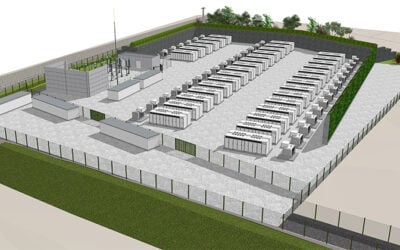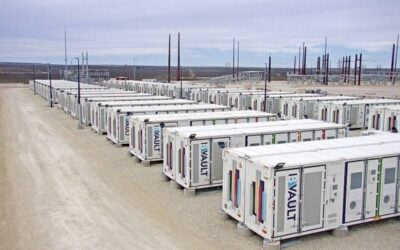
The UK’s energy regulator Ofgem has launched a new cap and floor investment support scheme in an effort to unlock billions in funding for new Long Duration Electricity Storage (LDES) projects.
The launch of the scheme is the end of a collaborative process between the Department for Energy Security and Net Zero (DESNZ), the National Energy System Operator (NESO) and Ofgem, which began in October with the confirmation that a scheme discussed for the past couple of years would be introduced to regulate the minimum and maximum profits that LDES developers could face for projects, in a similar manner to the scheme already in place for interconnector projects (Editor’s note: although ‘LDES’ usually denotes ‘long-duration energy storage’, the Ofgem scheme specifically targets electricity-storing resources).
This article requires Premium SubscriptionBasic (FREE) Subscription
Enjoy 12 months of exclusive analysis
- Regular insight and analysis of the industry’s biggest developments
- In-depth interviews with the industry’s leading figures
- Annual digital subscription to the PV Tech Power journal
- Discounts on Solar Media’s portfolio of events, in-person and virtual
Or continue reading this article for free
A call for input into the scheme ran between December 2024 and January of this year, and a Technical Decision Document on the scheme was published last month.
Developers able to deliver LDES projects by 2030 and 2033 to meet the government’s Clean Power 2030 target are now being invited to apply to the scheme, with applications closing on 9 June 2025. The first projects are expected to be approved by Q2 of 2026.
The aim of the cap and floor regime is to encourage developers to build LDES projects in order to support the growing need for energy storage to balance a grid powered more prominently by variable sources of renewable energy.
Although DESNZ and NESO have called the expansion of LDES “crucial” to the future of the UK’s net zero ambitions, no new LDES infrastructure has been built in the last four decades owing to numerous barriers, including high upfront costs.
The cap and floor regime solves this by setting minimum and maximum revenues that can be gained from LDES projects. The minimum revenue floor is expected to increase investor confidence and thus encourage private investment into LDES projects by providing minimum revenue for LDES operators to help manage start-up costs and long build times.
Meanwhile, the scheme ensures value for money for UK energy consumers by only allowing efficient projects with a storage duration of over eight hours to take part and sets a maximum cap on profits, with any excess revenue fed back to customers via their bills.
Government analysis has found that with 20GW of LDES, the target set for 2050, the UK electricity system could save as much as £24 billion (US$31.24 billion) between 2030 and 2050. Meanwhile, NESO’s Future Energy Scenarios report advised the government to add between 2.7GW to 7.7GW of stored power by 2035, around double Britain’s current strategic reserve spread across four pumped hydro storage schemes in Scotland and Wales.
To read the full version of this story, visit Solar Power Portal.
Held alongside the Battery Show Expo Europe in Stuttgart, Energy Storage Germany spotlights Germany’s rapid ascent in the European storage sector. Once driven by residential demand, utility-scale projects are now surging, with 184 MW added across 44 projects in 2023. With nearly 16 GWh of capacity installed in the first half of 2024, Germany is set to integrate 24 GW of utility-scale energy storage by 2037, creating substantial opportunities.
The UK & Ireland is the most mature and established energy storage market in Europe, with just over 5GW of total operational capacity at the start of 2025. With over 130GW in the pipeline for the UK and Ireland, the growth potential of this market is immense. With this in mind, everyone is asking, ‘how best to maximise battery assets?’ This event has established itself as a key industry platform, bringing together asset owners with the experts who can provide the answers – from optimisers and software providers to O&M specialists and more. The summit will equip the industry for the future, delving into the key pillars of asset management, exploring operational challenges, and spotlighting the latest developments in optimisation and software innovation.
Across two packed days, the Summit focused on three core themes: revenue & trading, the lifecycle of the battery, and optimisation tools. Attendees explored innovative strategies for enhancing asset performance and longevity, with a spotlight on key markets like Germany, Italy, and the UK. Stay tuned for details on the 2025 edition of the Battery Asset Management Summit Europe, where we’ll continue to chart the path forward for energy storage asset management.
InterContinental London – The O2, London, UK
This isn’t just another summit – it’s our biggest and most exhilarating Summit yet! Picture this: immersive workshop spaces where ideas come to life, dedicated industry working groups igniting innovation, live podcasts sparking lively discussions, hard-hitting keynotes that will leave you inspired, and an abundance of networking opportunities that will take your connections to new heights!
cap and floor, clean power 2030, DESNZ, EnergyStorageEurope, investment, ldes, long-duration energy storage, neso, revenue underwriting, support scheme, uk
Read Next
The Queensland government has announced plans to release a five-year Energy Roadmap and transferred oversight of a 20GWh PHES project.
Financial close was achieved on a 270MWh battery storage project in Belgium by removing as much asset and revenue risk as possible, Energy-Storage.news has heard.
Australia’s energy minister has argued that the upcoming federal election is a “sliding doors moment” for the country’s energy transition.






